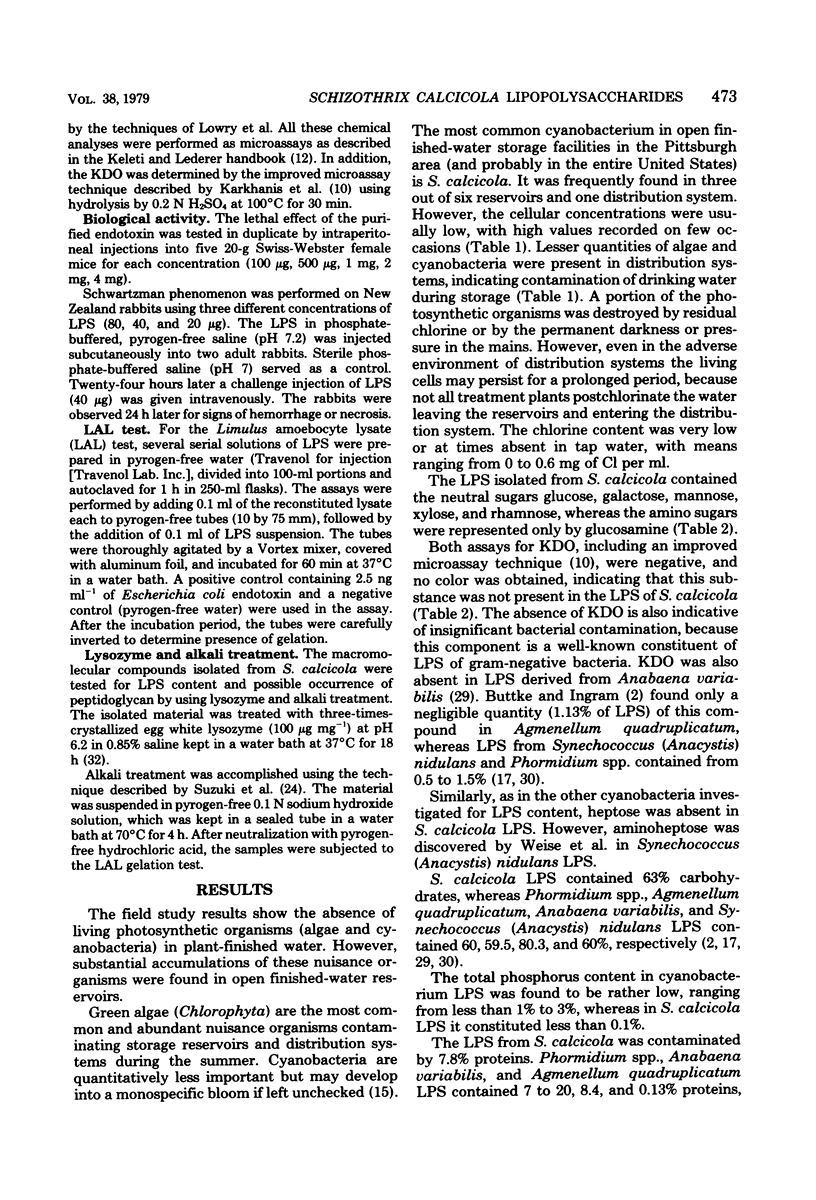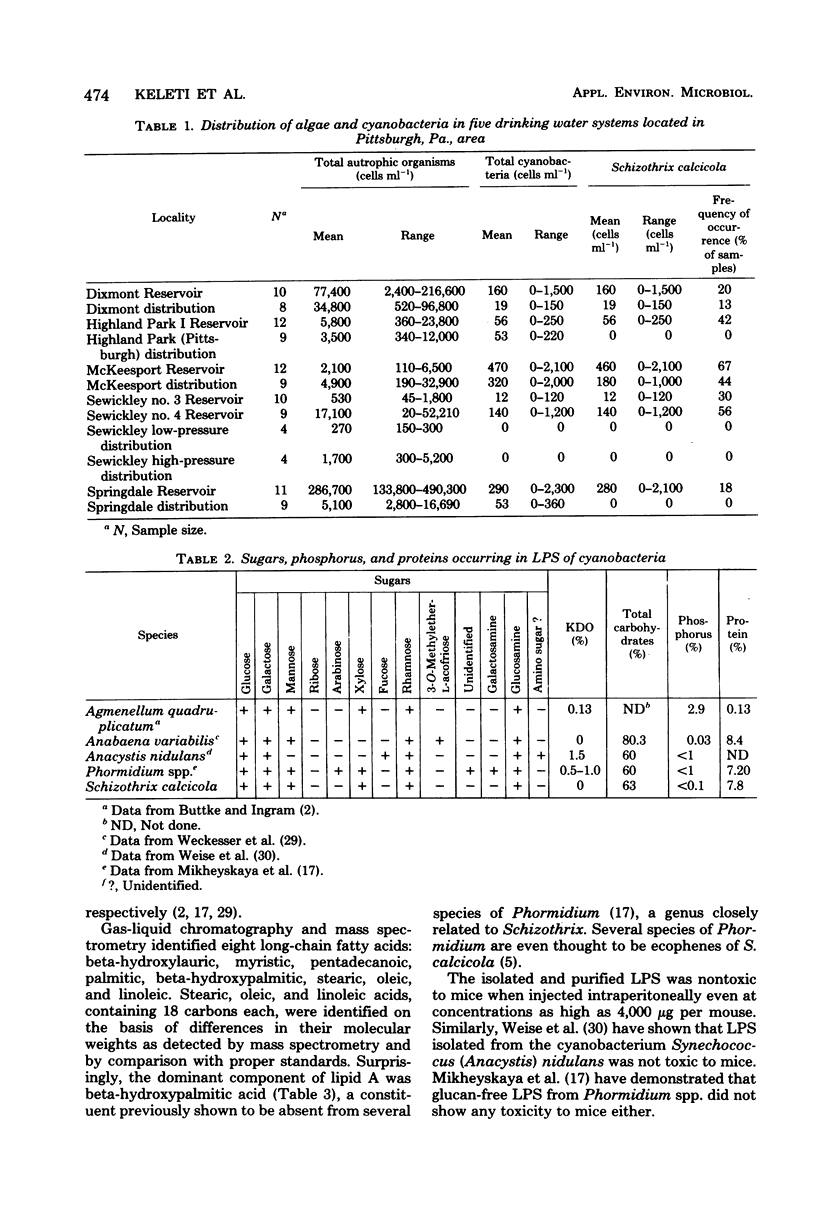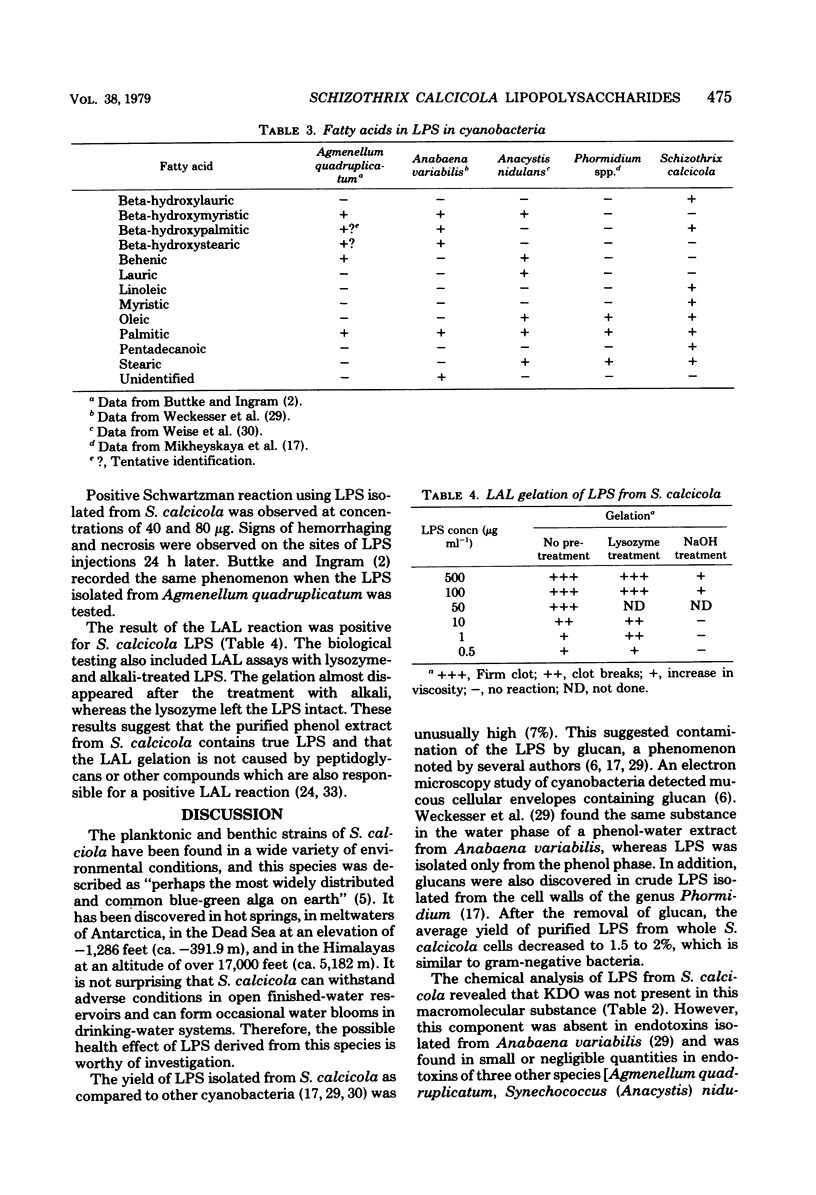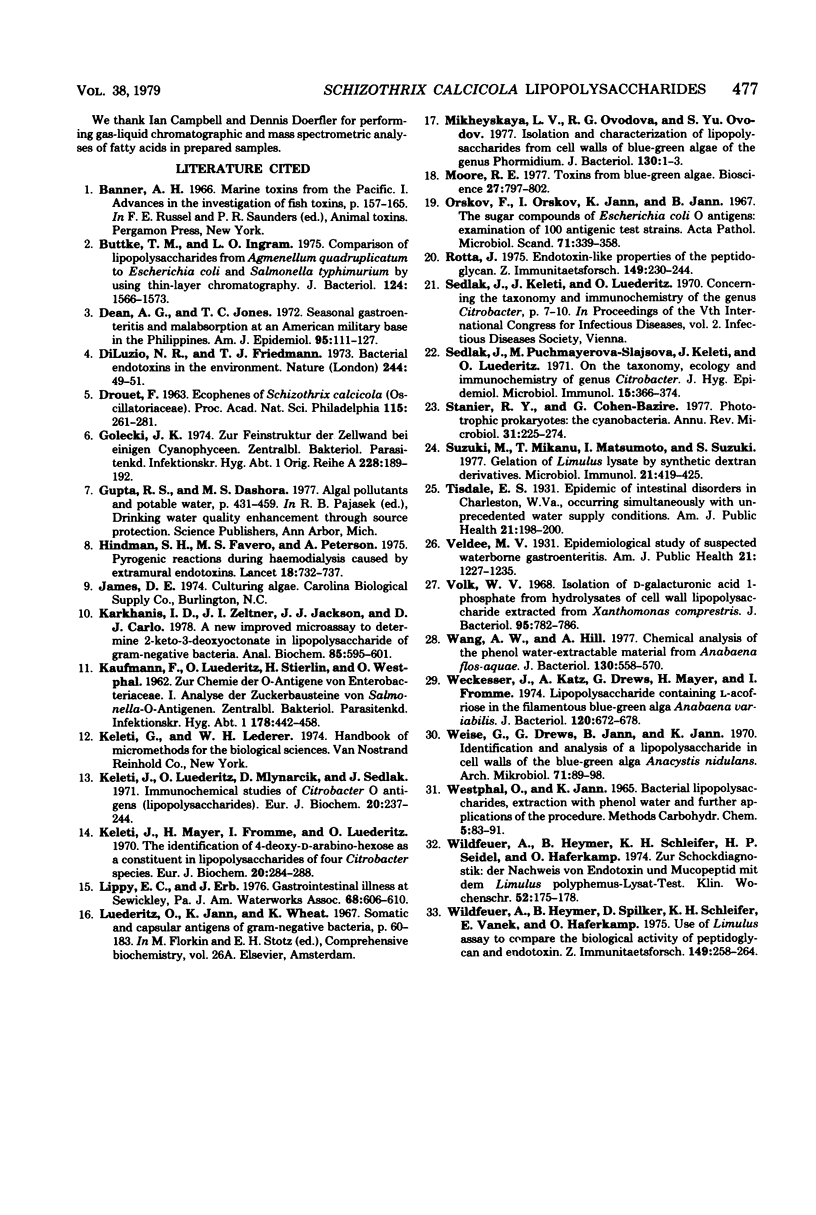Abstract
The most common cyanobacterium contaminating drinking water systems in southwestern Pennsylvania is Schizothrix calcicola. Lipoplysaccharides (LPS) were isolated from this species by hot phenol-water extraction. The polysaccharide moiety was composed of glucosamine, galactose, glucose, mannose, xylose and rhamnose. The lipid A part contained beta-hydroxylauric, myristic, pentadecanoic, palmitic, beta-hydroxypalmitic, stearic, oleic, and linoleic acids. In contrast to many LPS isolated from Enterobacteriaceae, the dominant component was not beta-hydroxymyristic but beta-hydroxypalmitic acid. The LPS induced Limulus lysate gelation and Schwartzman reaction but was nontoxic to mice. The identity of LPS was verified by alkali and lysozyme treatment. The results suggest that S. calcicola is one of the principal sources of endotoxins in water systems using open finished-water reservoirs.
Full text
PDF






Selected References
These references are in PubMed. This may not be the complete list of references from this article.
- Buttke T. M., Ingram L. O. Comparison of lipopolysaccharides from Agmenellum quadruplicatum to Escherichia coli and Salmonella typhimurium by using thin-layer chromatography. J Bacteriol. 1975 Dec;124(3):1566–1573. doi: 10.1128/jb.124.3.1566-1573.1975. [DOI] [PMC free article] [PubMed] [Google Scholar]
- Dean A. G., Jones T. C. Seasonal gastroenteritis and malabsorption at an American military base in the Philippines. I. Clinical and epidemiologic investigations of the acute illness. Am J Epidemiol. 1972 Feb;95(2):111–127. doi: 10.1093/oxfordjournals.aje.a121376. [DOI] [PubMed] [Google Scholar]
- Di Luzio N. R., Friedmann T. J. Letter: Bacterial endotoxins in the environment. Nature. 1973 Jul 6;244(5410):49–51. doi: 10.1038/244049a0. [DOI] [PubMed] [Google Scholar]
- Golecki J. R. Zur Feinstruktur der Zellwand bei einigen Cyanophyceen. Zentralbl Bakteriol Orig A. 1974;228(1):189–192. [PubMed] [Google Scholar]
- Hindman S. H., Favero M. S., Carson L. A., Petersen N. J., Schonberger L. B., Solano J. T. Pyrogenic reactions during haemodialysis caused by extramural endotoxin. Lancet. 1975 Oct 18;2(7938):732–734. doi: 10.1016/s0140-6736(75)90721-7. [DOI] [PubMed] [Google Scholar]
- KAUFFMANN F., LUEDERITZ O., STIERLIN H., WESTPHAL O. [On the immunochemistry of O antigens of Enterobacteriaceae. I. Analysis of the sugar component of Salmonella O antigens]. Zentralbl Bakteriol. 1960 May;178:442–458. [PubMed] [Google Scholar]
- Karkhanis Y. D., Zeltner J. Y., Jackson J. J., Carlo D. J. A new and improved microassay to determine 2-keto-3-deoxyoctonate in lipopolysaccharide of Gram-negative bacteria. Anal Biochem. 1978 Apr;85(2):595–601. doi: 10.1016/0003-2697(78)90260-9. [DOI] [PubMed] [Google Scholar]
- Keleti J., Lüderitz O. Immunochemical studies on Citrobacter O antigens (lipopolysaccharides). Eur J Biochem. 1971 May 28;20(2):237–244. doi: 10.1111/j.1432-1033.1971.tb01386.x. [DOI] [PubMed] [Google Scholar]
- Keleti J., Mayer H., Fromme I., Lüderitz O. The identification of 4-deoxy-d-arabino-hexose as a constituent in lipopolysaccharides of four Citrobacter species. Eur J Biochem. 1970 Oct;16(2):284–288. doi: 10.1111/j.1432-1033.1970.tb01083.x. [DOI] [PubMed] [Google Scholar]
- Miller A. P., Tisdale E. S. PUBLIC HEALTH ENGINEERING: EPIDEMIC OF INTESTINAL DISORDERS IN CHARLESTION, W. VA., OCCURRING SIMULTANEOUSLY WITH UNPRECEDENTED WATER SUPPLY CONDITIONS. Am J Public Health Nations Health. 1931 Feb;21(2):198–200. doi: 10.2105/ajph.21.2.198. [DOI] [PMC free article] [PubMed] [Google Scholar]
- Rotta J. Endotoxin-like properties of the peptidoglycan. Z Immunitatsforsch Exp Klin Immunol. 1975 Jul;149(2-4):230–244. [PubMed] [Google Scholar]
- Sedlák J., Puchmayerová-Slajsová M., Keleti J., Lüderitz O. On the taxonomy, ecology and immunochemistry of genus Citrobacter. J Hyg Epidemiol Microbiol Immunol. 1971;15(4):366–374. [PubMed] [Google Scholar]
- Stanier R. Y., Cohen-Bazire G. Phototrophic prokaryotes: the cyanobacteria. Annu Rev Microbiol. 1977;31:225–274. doi: 10.1146/annurev.mi.31.100177.001301. [DOI] [PubMed] [Google Scholar]
- Suzuki M., Mikami T., Matsumoto T., Suzuki S. Gelation of Limulus lysate by synthetic dextran derivatives. Microbiol Immunol. 1977;21(8):419–425. doi: 10.1111/j.1348-0421.1977.tb00307.x. [DOI] [PubMed] [Google Scholar]
- Veldee M. V. An Epidemiological Study of Suspected Water-borne Gastroenteritis. Am J Public Health Nations Health. 1931 Nov;21(11):1227–1235. doi: 10.2105/ajph.21.11.1227. [DOI] [PMC free article] [PubMed] [Google Scholar]
- Volk W. A. Isolation of D-galacturonic acid 1-phosphate from hydrolysates of cell wall lipopolysaccharide extracted from Xanthomonas campestris. J Bacteriol. 1968 Mar;95(3):782–786. doi: 10.1128/jb.95.3.782-786.1968. [DOI] [PMC free article] [PubMed] [Google Scholar]
- Wang A. W., Hill A. Chemical analysis of the phenol-water-extractable materials from Anabaena flos-aquae. J Bacteriol. 1977 Apr;130(1):558–560. doi: 10.1128/jb.130.1.558-560.1977. [DOI] [PMC free article] [PubMed] [Google Scholar]
- Weckesser J., Katz A., Drews G., Mayer H., Fromme I. Lipopolysaccharide containing L-acofriose in the filamentous blue-green alga Anabaena variabilis. J Bacteriol. 1974 Nov;120(2):672–678. doi: 10.1128/jb.120.2.672-678.1974. [DOI] [PMC free article] [PubMed] [Google Scholar]
- Weise G., Drews G., Jann B., Jann K. Identification and analysis of a lipopolysaccharide in cell walls of the blue-green alga Anacystis nidulans. Arch Mikrobiol. 1970;71(1):89–98. doi: 10.1007/BF00412238. [DOI] [PubMed] [Google Scholar]
- Wildfeuer A., Heymer B., Schleifer K. H., Seidel H. P., Haferkamp O. Zur Schockdiagnostik: Der Nachweis von Endotoxin und Mucopeptid mit dem Limulus polyphemus-Lysat-Test. Klin Wochenschr. 1974 Feb 15;52(4):175–178. doi: 10.1007/BF01614393. [DOI] [PubMed] [Google Scholar]
- Wildfeuer A., Heymer B., Spilker D., Schleifer K. H., Vanek E., Haferkamp O. Use of limulus assay to compare the biological activity of peptidoglycan and endotoxin. Z Immunitatsforsch Exp Klin Immunol. 1975 Jul;149(2-4):258–264. [PubMed] [Google Scholar]


